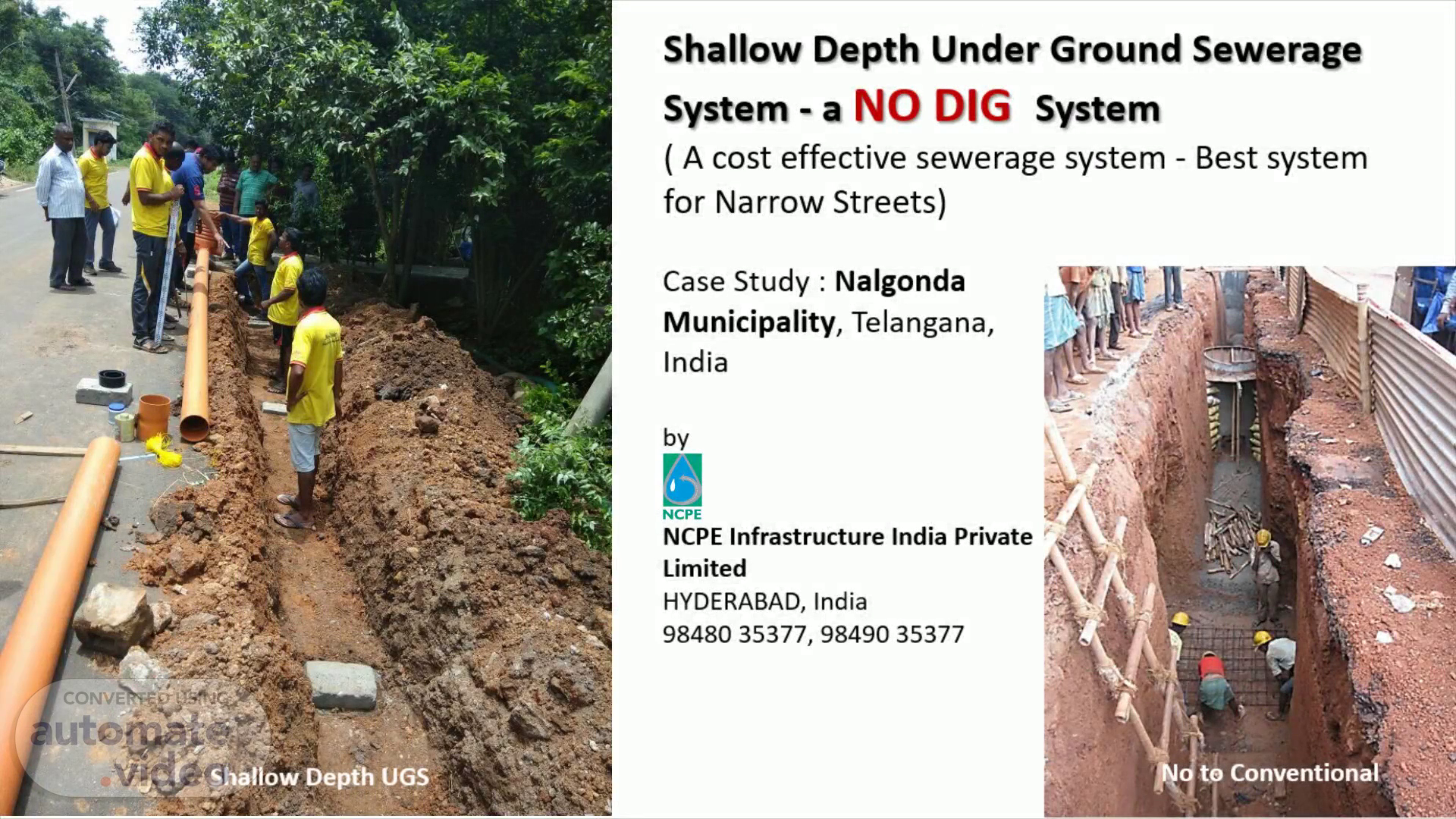
PowerPoint Presentation
Scene 1 (0s)
[Audio] Hi I am Dr Subhani, an Urban Infrastructure Designer working in designing of Water Supply and Under Ground Sewerage System Since 1998 that is more than Two Decades. This brief presentation is an outcome of hard effort of more than couple of years put by my colleagues to really say that the Shallow Depth Sewerage System is an alternate to Conventional Sewerage System. Before getting in to the technical aspects, our understanding of the present system is.
Scene 2 (30s)
[Audio] India has More than 4000 ULBs More than 40 Crore Population is residing in these ULBs One lakh population is an average size of ULB Got about 800000 kilometres of road network in all ULBs Not less than 400000 kilometres are covered/paved with CC or BT Roads Not even 40000 kilometres are covered with under ground sewerage system till date To meet Service Level Bench Marks that is SLBMs, there is no other option except digging these roads sometime or the other if UGS System is done with CONVENTIONAL SYSTEM To reconstruct of roads alone, it is going to cost about two lakh Crore alone for reconstruction of roads besides another three lakh crore required to lay sewer lines that is besides treatment facilities and O & M Cost. Will brief now how opting this shallow depth UGS is an advantage than the conventional system.
Scene 3 (1m 35s)
[Audio] Traditionally, sewerage system is designed for 80 percent of water supplied now it is more than 95 percent and sewer lines are laid in the middle of the road irrespective of whether these are lateral, sub mains or trunk mains. The sewage or sullage or from households are connected to the manholes of sewerage system by connecting to Inspection Chamber which is constructed at property edge and will be connected with 100 mm or 150mm dia pipe line to manhole which is called as house service connection. In the process of construction of sewer lines, manholes and house service connections, the entire road will be digged..
Scene 4 (2m 14s)
[Audio] Generally road will be digged in such a manner that hardly place is left for movement of public to reach their houses. They forced to park their vehicles at unsecured place and with a great difficulty reaches their destination. In general, the user is troubled for more than a week time if that agency is well performing one and even after completion also.
Scene 5 (2m 38s)
[Audio] The trouble continues. Even after relaying roads, this how the status due to poor compaction. We are observing this situation since a long time and policy makers are almost taking a decision not to go for under ground sewerage system and.
Scene 6 (2m 57s)
[Audio] The user is compelled to stay in the same unhygienic condition. The above picture in Nalgonda Municipality resembles the poor condition of drainage system in that area. Though policy makers are not in favor, the Commissioner, Nalgonda Municipality is took lot of interest in convincing members of municipal councils that is councilors, chairperson, MLA and requested NCPE to come out with an highly economic, workable, maintenance free and least to the existing infrastructure and minimum disturbance to people of than street. This is how we came with this new proposal..
Scene 7 (3m 35s)
[Audio] It is worth while to mention here that, this system is very well suggested in new CPHEEO sewerage manual, but hardly efforts are put to bring to practice. It is in 2018, the Government of Andhra Pradesh has taken interest and successfully implemented in many areas and looking at comfort running only, we have proposed this system for Nalgonda Municipality. As suggested in manual, the lateral sewer lines will be constructed on both sides of the road ( parallel to the property line) and with a depth of 0.3 meters that is soffit level. The sewer lines itself will have inspection chambers and no need to go for traditional manholes. All lateral can go with this system and sub mains and trunk mains can be executed in traditional method. It is to mention here that the lateral lengths in acity varies from 80 to 85 percent of total sewer network. That means 80 percent can be constructed with half of the cost likely to incur in construction of lateral sewer lines..
Scene 8 (4m 41s)
[Audio] The Nalgonda Municipality is spread over an area of 105 square kilometres and is having about 2.25 lakh population at present. Based on topography, the entire area is divided in to nine zones and the sewerage system is available in four zones that is covering core area of city (Zone 1, 2 , 3 and 4). Zone 8 is taken for the purpose of comparative assessment. The area of of zone 8 is about 8 Square kilometers and having about 28,000 population at present and design is year population is about 50,000. This zone has about 80 kilometers of road network and all households in this zone are connected to septic tanks..
Scene 9 (5m 31s)
[Audio] The comparative statement reflects that. Sorry Information yet to be filled give us sometime..